
Mainland Moose Frequently Asked Questions
1. Where are moose located on the mainland?
2. What is the difference between mainland moose and Cape Breton moose?
3. How many moose are found on Cape Breton? What is the mainland population?
4. Why is the moose population endangered in mainland Nova Scotia?
5. Does habitat loss, development and forest harvesting cause low moose numbers?
6. Is poaching an important factor in the decline of mainland moose?
7. Can moose be legally hunted on the mainland?
8. Why are moose susceptible to brain worm and deer are not?
9. What is being done to protect mainland moose?
10. Why can’t you just bring moose from Cape Breton or New Brunswick to the mainland?
11. What can the public do to help in the recovery of mainland moose?
12. Who should moose sightings be reported to?
13. If the public reports a sick moose, what happens next?
14. Are ticks a problem to Nova Scotia moose?
15. What types of moose surveys are being done? Why?
16. Why are radio collars used in studies?
17. How many calves do cows have per year?
18. What is moose habitat?
19. What do moose eat?
20. How old do moose get?
21. Do moose have natural predators?
22. Do all moose have horns?
23. When do moose breed?
1. Where are moose located on the mainland?
The remaining sub-populations where moose continue to persist on mainland Nova Scotia are in the Tobeatic Region, Chebucto Peninsula, Cobequid Mountains, Pictou-Antigonish highlands, and the interior of the eastern shore area from Tangier Grand through Guysborough. These areas on the mainland, appear to be the most isolated areas with poor access.
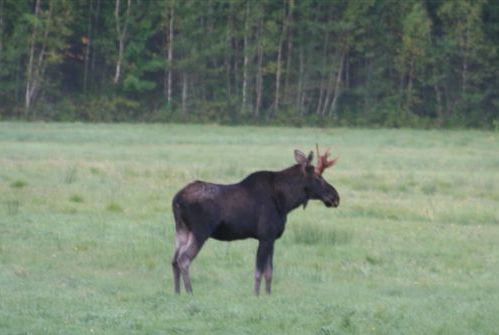
2. What is the difference between mainland moose and Cape Breton moose?
The mainland moose and the Cape Breton moose are two separate sub-species. On the mainland, the moose are Alces americana and in Cape Breton the species is Alces andersonii. The original indigenous population of Alces americana in Cape Breton was extirpated in the late 1800's - early 1900's. The cause of this extirpation remains unknown. The current population in Cape Breton started from the introduction of 18 Alces andersonii moose from Alberta in 1947 and 1948. The moose from the mainland are native to eastern North America.
3. How many moose are found on Cape Breton? What is the mainland population?
The Cape Breton Island population currently numbers about 5,000 animals. The mainland moose population is estimated at 1,000 animals or less. Aerial and ground surveys have been used to estimate the moose population.
4. Why is the moose population endangered in mainland Nova Scotia?
There are a number of threats to the mainland moose population. These include disease (i.e. P. tenius (brainworm), illegal kill (i.e. poaching), calf predation by black bears, habitat alteration and increased access, disturbance and possibly climate change and acid rain.
top
5. Does habitat loss, development and forest harvesting cause low moose numbers?
Moose are known as generalists and can utilize a variety of habitats. Since their diet consists largely of saplings, forest harvesting often provides a valuable food source for the moose. However, the loss of mature forests due to harvesting and development can be detrimental to moose if there are not adequate stands of various age forest communities to provide food, shelter, security and connectivity of these various habitat components. In the winter when the snow is deep, mature forests are an essential component of moose habitat. These forest types provide shelter and reduce snow levels beneath a closed canopy forest, allowing the moose to travel more easily and expend less energy while searching for food. Another problem with forest harvesting is that more road access is created, which allows for greater disturbance of moose by OHV’s, and other recreationists.
6. Is poaching an important factor in the decline of mainland moose?
Yes, poaching is a threat to the mainland moose population. Further, the advent of snowmobiles, all-terrain vehicles and the popularity of four wheel drive cars and pick-up trucks have enhanced the ability of poachers to access moose habitat and more easily remove a large animal carcass. You can report a poacher by calling 1-800-565-2224 or reporting online .
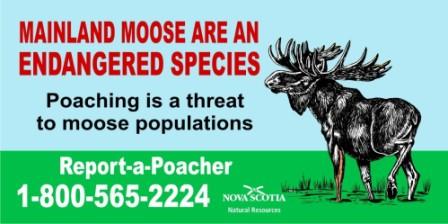
top
7. Can moose be legally hunted on the mainland?
No. The last legal season for hunting moose was in 1936 in the western end of the province and in 1981 in the eastern end. Numbers have continued to decline even in the absence of legal hunting. Because there is a conservation concern even Mi’kmaq harvesters are not permitted to hunt the endangered moose on the mainland.
8. Why are moose susceptible to brain worm and deer are not?
The internal parasitic worm, Parelaphostrongylus tenius, is believed to have evolved with white-tailed deer over hundreds, if not thousands of years. The brain worm has evolved to live within a deer and the intermediate hosts of snails and slugs, without being a significant detriment to these animals.
Moose thrive in the northern boreal forests where deer have not been able to survive because of deep snows in winter. Therefore, moose have had little exposure to the brain worm. Moose have not had time (in an evolutionary sense) to build its immune defenses to the brain worm, nor has the parasite had adequate time and exposure to moose to adapt to the slightly different metabolism of a moose.
top
9. What is being done to protect mainland moose?
In 2003 a status report on mainland moose was released. Following this report, the mainland moose was listed as an endangered species under the Nova Scotia Endangered Species Act. In accordance with this Act, a Recovery Plan for Mainland Moose was developed by a recovery team made up of the most knowledgeable moose biologists/ecologists in the maritime provinces. The plan was subsequently completed in spring 2007. The plan lists a number of action items that will be instrumental in the recovery of this species. One of these action items is to increase public awareness and public involvement in recovery efforts. To this end a communication plan is being formulated, focusing on public education with an emphasis on the importance of reporting moose sightings and poaching, as well as reducing disturbance of moose and managing Nova Scotia’s woodlands to better accommodate the needs of moose. In the past, there have also been many research projects which studied food and habitat of mainland moose. Understanding the life history requirements of moose and the availability of these resources is necessary in the recovery process.
10. Why can’t you just bring moose from Cape Breton or New Brunswick to the mainland?
The moose population in Cape Breton is a separate sub-species then those on mainland Nova Scotia. In other words they have a different genetic make-up. The moose that have survived to date on mainland, should be the best suited animals to survive here. Bringing in moose of a different genetic strain may in fact compromise the ability of these moose to survive the different climate and threats on the mainland.
Further, until all of the factors affecting mainland moose are fully understood and hopefully removed or minimized, bringing in more moose (at great expense and high stress to the animals involved) may result in these animals dying of the same causes (i.e. poaching, range abandonment due to lack of security, the brain worm, some yet to be discovered health problems, etc.).
Within the order of 1,000 mainland moose remaining, there should not have been a genetic “inbreeding” problem develop. This issue is currently being studied. If inbreeding (or a lack of genetic diversity) is found to be a problem, the mainland population could be augmented by bringing animals from New Brunswick, which are of the same genetic background, as they were at one time a continuous population.
top
11. What can the public do to help in the recovery of mainland moose?
The public can help by reporting moose sightings. Valuable information about location, habitat, and health can be gained from sighting reports. Further if a moose is reported repeatedly in the same general location, Department of Natural Resources and Renewables staff will investigate. In some cases these may be “sick” animals, which would be studied to learn more about possible health and condition problems. In some cases these sick animals can be brought into a special quarantine facility at the Provincial Wildlife Park in Shubenacadie where they can be monitored and studied by a veterinarian who is a wildlife health specialist.
Reporting of illegal activities is another way in which the public can help. Poaching is a threat to the mainland moose population and Conservation Officers can be much more effective in apprehending these criminals with timely information provided by the public.
Disturbance is another threat to moose, individuals who see moose while enjoying hiking, skiing, ATVing and snowmobiling can minimize their impact by maintaining distance between the animal and themselves. Moose often freeze when disturbed and adopt what people mistake as a calm and unaffected behavior. Bristling of hair along their neck and back is a sign of stress. Disturbance of this kind can cause moose to disperse to less favorable habitat where food quality is low and they may not be able to meet their food nutritional requirements.
12. Who should moose sightings be reported to?
Moose sightings can be reported online or by phoning your local Department of Natural Resources and Renewables office. Also all hunters and trappers receive a moose sighting report form in their annual Hunting and Furharvesting Licence and Summary of Regulations booklet. Sightings should include location, number of moose, and sex/age class (if known) of moose. Tracks and scat of moose should be reported as well. Carcasses or even old moose bones found in the woods should be reported as this could indicate illegal activity or provide insight into a disease or health problem.
top
13. If the public reports a sick moose, what happens next?
Reports of “sick” moose are investigated by Department of Natural Resources and Renewables Staff. If warranted, sick moose are tranquilized by NR&R Staff, and transported to Shubenacadie Wildlife Park via a recently purchased horse trailer. At the wildlife park moose are housed in a quarantine facility, where their health is monitored. Moose that recover are released back into the wild. Those whose health continues to deteriorate are humanely euthanized. The carcass of euthanized moose are sent to the Atlantic Veterinary College at UPEI, where a complete necropsy is performed in order to learn the condition of the animal at the time of death, the cause of death and to look for potential abnormalities, which could indicate health problems in the population.
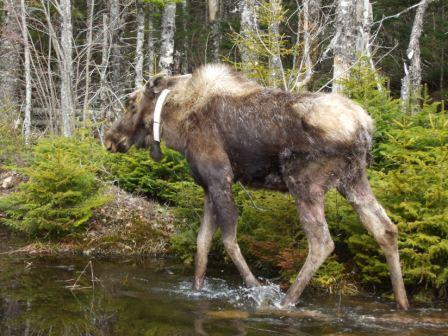
14. Are ticks a problem to Nova Scotia moose?
Yes. On the mainland they can be an occasional problem, but not in Cape Breton where snow cover lasts well into the spring in the highlands and ticks are not able to survive. These ticks are known as the moose tick or winter tick (Dermacentor albipictus). Severely infected moose can be host to 30,000 or more ticks. Ticks feed on blood and a severe infestation can equal large losses of blood. Infected moose also spend copious amounts of time grooming, which means they are spending less time eating. Another symptom of infection is hair loss. Since these infections occur in the winter, loss of hair can reduce the moose’s ability to thermoregulate. Winter ticks cause death by a combination of blood loss, hair loss and distraction from feeding.
top
15. What types of moose surveys are being done? Why?
Determining how many moose are in mainland Nova Scotia is instrumental in determining how to focus recovery efforts. In the past aerial surveys looking for moose and ground surveys looking for moose scat and tracks have been used. Department of Natural Resources and Renewables in conjunction with university researchers are in the process of developing a new technique combining both methods to increase the accuracy of the count. Surveys in the recent past, together with observation reports by the public, have assisted in estimating the population to be between 500 and 1,000 animals.
16. Why are radio collars used in studies?
Radio collars are used to study many different species. Collars are an important research tool because they allow a researcher to find and study a particular animal, repeatedly and at any given time. The locations obtained by tracking animals with GPS (Global Positioning System) collars can be used to determine the home range size (i.e. the area each animal travels, lives and eats in), determine what type of habitat is being utilized, and locate salt licks and summer aquatic feeding habitat. Locating the animals from a helicopter allows the researcher to determine if the moose are traveling alone or in a group, or how many, if any calves are present. They can also get a general idea of the health and condition of the collared moose and other moose that are traveling with it. Most collars are equipped with a mortality sensor so that if the animal (i.e. collar) does not move for a period of time (can be set for different periods) then the collar transmits a different signal. This allows the researcher to locate the carcass more quickly which may help to determine the cause of death.
top
17. How many calves do cows have per year?
Moose produce either a single or twin calf each year. Triplets have been recorded but incidents are rare. In good habitat, cow moose can give birth when they are 2 years old. Nearly all 3 year old cows produce calves and they will every year for the remainder of their life (approximately 10-12 years). Calves are usually born around the first of June when the weather is warm and there is plenty of new green vegetation to meet their mother’s nutritional needs while producing milk for their nursing calf or calves.
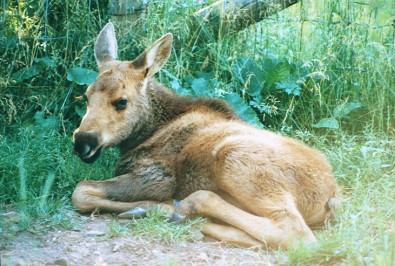
Habitat refers to the place where an animal lives. It represents food, water, shelter and space. Moose are referred to as “generalists” which means they are able to use a variety of habitats equally well. In Nova Scotia moose use mixed wood forests with lakes and streams for summer aquatic feeding habitat high quality winter browse, mature forest shelter areas that allow access to food; isolated sites for calving; and young forest stands with deciduous shrubs are essential components of moose habitat. In winter, food close to shelter in a mature conifer forest is especially important because in deep snow moose may expend more energy then they gain if they have to work too hard to find food.
top
Moose are herbivores. They consume twigs, leaves, pondweed etc. In Nova Scotia moose consume parts from such trees as sugar maple, red maple, yellow birch and balsam fir. Moose are selective about the parts of the plants that they consume especially when forage quality and quantity are high. Selection varies depending on location and type of forage available. When food supply is low, usually in late winter, moose will strip and eat the bark of some trees. In the summer moose also eat aquatic vegetation such as pond weed and water lily. Aquatic vegetation is of high value to moose in replenishing nutrients lost during winter and required for antler growth (bulls) and for producing milk (cows).
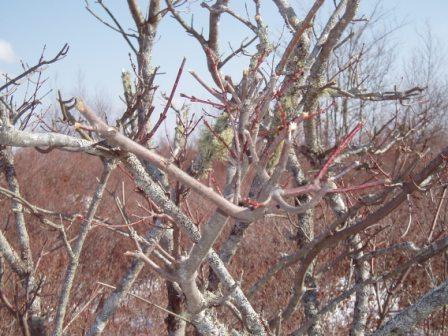
In populations that are heavily hunted the average life span of moose is between 4 and 5 years of age. In an un-hunted population such as the mainland moose population the average life span is slightly higher, between 10 and 13 years of age. However in Nova Scotia some moose live into their 20's.
top
21. Do moose have natural predators?
In Nova Scotia, the Black Bear is the only known predator of moose. Black bear prey mainly on calves, but could attack old or injured moose as well. It is unknown how many moose calves are killed each year. It has been suggested that coyotes may also play a role in moose calf predation.
Moose do not have horns, they have antlers and only bull(male) moose have antlers. Bovines grow horns, these are permanent, unbranched structures that grow from the base. Antlers grow from the tip and are shed in January/February each year. In a bull’s prime (usually between the ages of 5 and 12) new, often larger antlers grow back in late spring/early summer. They grow under velvet until September when the velvet is rubbed off on branches and the new antlers are revealed. Antler growth is dependant on the health and nutrition of the animal. If antlers are damaged during their growing period, they can become malformed.
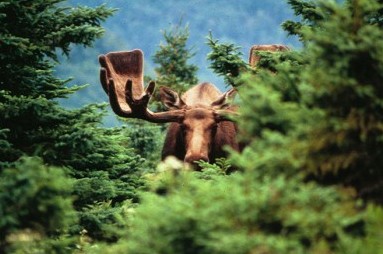
top
Moose breed in September/October, this period is commonly referred to as “the rut”. Calves are born approximately 8 months later, in late May/Early June.